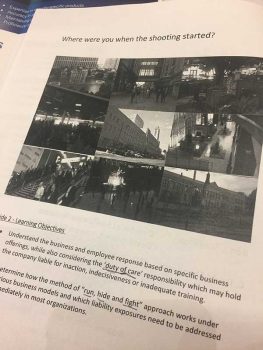5 Critical Things You Must Do In An Active Shooter Situation
Author: David Strickland
At Kenton Brothers, one of our core values is Continuous Learning. So when presented with the chance to attend classes or conferences, we feel like it’s a great investment for not only ourselves but our customers too.
 I had the opportunity to attend the Active Shooter seminar “Dealing with Active Shooters” at ISC West in Las Vegas in April. I honestly didn’t know what to expect beforehand, but the topic is one that many of our customers worry about every day. The class was fantastic. The instructor was knowledgeable and had real world experience dealing with these situations.
I had the opportunity to attend the Active Shooter seminar “Dealing with Active Shooters” at ISC West in Las Vegas in April. I honestly didn’t know what to expect beforehand, but the topic is one that many of our customers worry about every day. The class was fantastic. The instructor was knowledgeable and had real world experience dealing with these situations.
I wanted to share my takeaways and give you some resources for planning your company’s response to this type of situation.
First, let’s talk about what you can do now, before an active shooter event happens. The advice shared is to have situational awareness at all times. Look for the things that are out of place and that your gut tells you are weird. These feelings are usually the first indicator that things could go wrong. Trust your gut. If you have a bad feeling… take steps to determine why. If you see someone approaching with a crazy look on their face, there’s a good chance they’re not trying to invite you to cocktails. Ready yourself or get out before there is a chance for violence.
During the class, the recommended process for active shooter response is RUN, HIDE, FIGHT. However, their instruction went beyond those steps. For instance, you can run, but where to? There are only two directions to go, toward the violence or away from it. How sure are you that you’re are headed in the right direction?
C. David Shepherd, former FBI and SWAT Member, boiled the process down to 5 things.
- Determine the Threat. Is it a person with a gun, multiple people with guns? Is it a person with a knife or chemical? Again, trust your gut and let all of your senses help you. Can you hear people screaming? Can you hear gunshots? Can you see smoke or smell it? Many times in these scenarios, it may take up to 30-45 seconds for someone to react because it takes time to process what is going on. Shortening this time could be critical for survival.
- Determine your distance from the threat. Where is this violence at? Is it in the next office? Is it in the lobby? Where are you in relationship to it? How long will it take for it to get to you? What is between you and it? Knowing this is critical because you don’t want to flee toward the violence. Is it better to bunker in place?
- Determine your quickest way to escape. What is the quickest way away from the violence? Could it be the stairs? Backdoor? What about the window? You must also take into consideration the following items: Who is with me, who do I have a duty of care to? Employees, Family members, patients, etc. How quickly can I get myself and those I am responsible for to safety?This can be greatly affected with prior planning. Take the time to notice the exits at the theater or hospital or even your office. If you can’t get out – bunker down or Hide. Lock doors, turn off lights, barricade doors stay away from windows and stay very quiet.
- Determine your ability to defend yourself. What are your skills and training? What is available around you to use as a defensive weapon? During the class, we spoke at length about different items such as concealed weapons, mace, pepper spray and even fire extinguishers. A fire extinguisher can be used as a “smoke screen” and a blunt instrument. Don’t forget chairs too. The goal is to get away. You may be able to incapacitate the shooter long enough to save yourself and family. The biggest lesson is that you must commit to your actions. If you are going to defend yourself, do it with a survivors mentality.
- Response to Authority. If you see police, immediately put your hands on your head and comply 100%. They will not know if you are the threat or an innocent. All of those details will be worked out later. Trust the process and follow directions.
These 5 tips will help in an active shooter or mass violence situation. I want to stress how important it is to have a plan. Not only for preventing and managing the situation, but how you will respond after a tragedy of this type effects your organization. Kenton Brothers can help guide you through this process. Give us a call.
Here are some additional links to use as resources:




Leave a Reply
Want to join the discussion?Feel free to contribute!